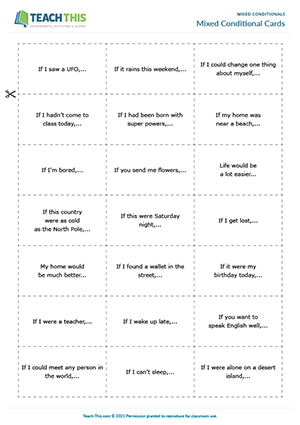Third Conditional speaking activity. Posted on June 12, 2015 by Gosia Kwiatkowska. For more speaking activities that help practice grammar see this devoted to using I’d rather / I’d prefer / It’s time or this one about same way question tags. Personal Experience.

A picture speaks a thousand words! And you can get your students speaking just as many by using pictures in class. Check out these fun and engaging communicative activities below. I find these work at all ages and the best thing is that each task can be adapted to the level you are teaching and designed with a particular language focus in mind so whether you’re teaching the Past Simple at A1 or the use of cleft sentences at C1, you can pull from your bank of pictures and adjust your instructions as you see fit!! Dialogue Bubbles Choose a picture with two or more people and in pairs, students design a catchy advertisement or witty dialogue OR use it to focus on a particular grammar structure such as ‘going to’ (see below). You could even choose a picture with two or more objects and ask your students to use their imaginations to add dialogue bubbles to the objects. This can be great fun, used at all levels and all ages and is so versatile in that you can focus on whatever grammar/vocabulary you are teaching that week!
A side panel provides comfortable navigation through your playlists, while the rest of the space displays songs in an organized table, with column headers for name, duration, artist, status, album, type, output, and remark. As far as the interface is concerned, accommodation is a walk in the park, with rather similar iTunes elements used in the design. M4p to mp3 converter freeware. The application allows you to select multiple items from different playlists.
2. Storyboards Storyboarding is a well-known and popular task in the ESL classroom but it means sourcing a sequence of pictures which can be a challenge! If you’re feeling very creative, you could take a series of images in sequence yourself and ask students to write the story. To personalise it even more, use your town or the school as a backdrop for the story. Storyboards are great to focus on particular grammar structures as you can assign the focus. For example, maybe ‘Past Perfect Continuous’ with your higher levels (He had been waiting for the right moment to save her) or Past Simple with your lower levels (He saved the woman and jumped out the window).
If I Were There, I Would Choose a picture in an interesting setting or location. This is a great task to practise the Second Conditional. ‘If I were there, I would get up early to watch the sunrise every morning.’ Can your students think of 3 Second Conditional sentences in relation to this setting? Picture Profiles Choose a small number of pictures of interesting people and get your students to work together to describe the appearance of the person in the picture but also to build a profile of that person using the following headings: Name, Nationality, Age, Profession, Likes/Dislikes, Life Goals and Ambitions and 3 words to describe the person’s character. When finished, groups can share their profiles and discuss their choices; a great way to practise present simple, present simple continuous and adjectives for description and character at the lower levels.
5. Yes, Chef! Take or source a picture of either a starter, a main course or a dessert. Ask your students to describe the dish to their partners including the ingredients that were used and the recipe they think would have been used.
Now, ask your students to come up with a five-course menu to include this dish! If you provide a picture like the one below of ‘Tiramisu’, your students might consider creating an Italian themed menu and should discuss Italian dishes and drinks. Nostalgia – ‘I remember when’ Bring in a picture of yourself as a young child and describe the picture to the class. Now, tell the students about this time in your life starting with i.e, ‘I remember when I was four years old’ This is a great task to practise structures such as ‘ I would’ and ‘ used to’ to talk about past habits.
Latest Pages
- Download Free Full Games Under 500mb
- Software Data Penduduk
- Watchguard Feature Key Keygen Free
- Living By The Book Howard Hendricks Pdf
- Torrent Anne Clark Discography
- Naan Ee Tamil Movie Download By Torrent
- Agni Parfene Noti
- Kak Zapustitj Payday The Heist Po Seti
- Secocut Programma Rascheta Rezhimov Rezaniya
- Upa Usb Programmer Software
- Contoh Program Dengan Visual Foxpro 9 Download
- Digital Painting Techniques Vol 1 Pdf